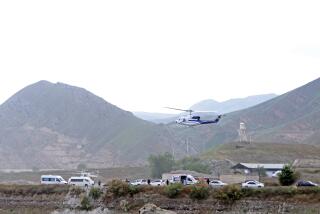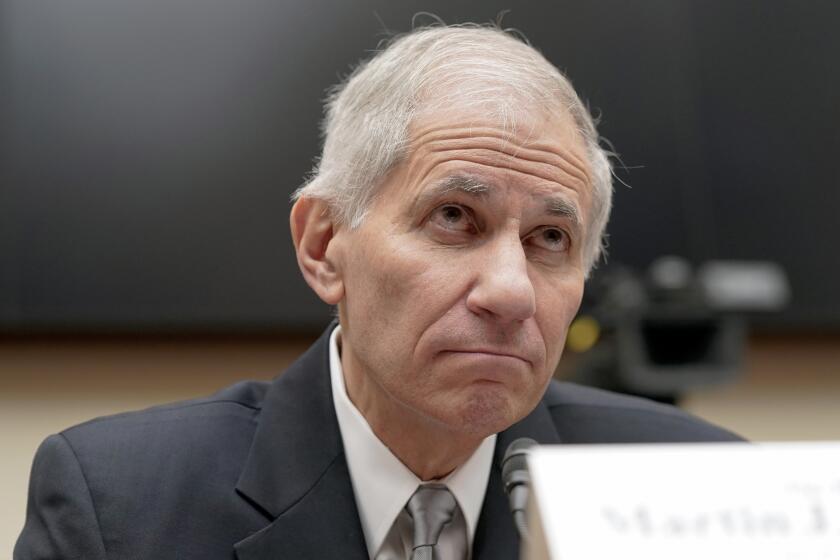Agony of Waiting Rivals That of Flooding
Kim Johnson hunkers down in her red van, cuddling her baby son and staring forlornly at her grimy house surrounded by ankle-deep mud. She can’t bear to step inside.
She already knows what’s there: chunks of dirt clinging like dead insects to living room blinds; moldy, crusty walls; even mushrooms sprouting from a greasy black-tar coating over what once was a pale mauve carpet.
It took Kim and Darin Johnson five years to redo their home, with new cherry wood cabinets, new plumbing and new appliances. Then the flood of a lifetime came, swallowing it in one nasty gulp--their house, their street and almost all of Grand Forks, turning it all into a vast, swampy ghost town.
Three months later, thousands of people are back in their homes, but thousands more are just beginning to cope with one immutable, frustrating fact: It will take months, even years, to restart their lives and rebuild Grand Forks.
For now, there’s little they can do but wait.
“Everything’s in limbo,” says Johnson, 29, who lives in an apartment with her husband and two children as they await the city’s bid to buy and demolish their house. “Our hands are tied. We’re still making a mortgage payment. We’re still paying taxes. We’re still paying insurance. This is still our home. But we can’t live here.”
Days before the Red River surged into the streets, Johnson fled to Minnesota, where she gave birth to her son, Austin. When she returned to her neighborhood--just a block from the levee--she quickly realized that she could not go home again.
Her husband has taken it in stride. “I didn’t plan on moving from here, but you can’t do anything about it,” says Johnson, a contractor whose business is now booming. “I’m just glad I don’t have to rebuild it.”
His wife, though, still yearns for the past.
“It’s not so much the loss of the home,” she says, almost apologetically. “It’s not so much the contents of the home. It’s just your life. . . . I want my life back. I’d give anything to have things the way they were.”
*
The streets of Grand Forks are dry, cars have replaced boats, American flags flutter from porches, clean water runs from the tap again.
But there are signs too that this is a town in transition: Outside a school, workers wearing respirators toss garbage into a tangled pile of rusty chairs and waterlogged bookcases. Down the block, folks line up for free garbage cans. Porta-Potties remain perched like statuary on front lawns, a reminder of the weeks when nothing seemed to work.
Here and there, graffiti capture the town’s weary psyche: “Site Seers Go Home” proclaims one message scrawled across the front of a deserted, flood-ravaged home; a hand-drawn arrow connected to the words “My Room Waz Here” eulogizes another home.
Almost everyplace, someone is waiting for something--a buyout offer, the demolition of a home, a business loan, a government trailer to live in temporarily until repairs are made.
Judy Haney is among them. Her home is scheduled to be torn down, but she still returns to lounge on her sun deck, reading the newspaper, remembering the good times of the last 29 years.
“There’s just the pain knowing you can’t go home to your bed,” she says wistfully, her eyes welling with tears. “I’ll keep going there until the day they demolish it. Then I won’t return.”
She lives in a trailer court now and ponders her next step.
“I feel like I’m on a camping trip,” she says ruefully, then adds: “I hope I can find a place before the first snowball hits.”
The city is just as eager to move fast: It plans to buy out 700 homes and build 250 new ones before winter.
Last month, it broke ground for 33 new homes and began began demolishing others.
And this month, it will open a trailer court for hundreds of displaced residents. The Federal Emergency Management Agency is providing the homes.
The flood’s economic wallop has been estimated at $2 billion, including residential, public and business losses; a chunk of that will be offset by hundreds of millions of dollars of federal aid and loans.
Private dollars have been a boon too, especially a $15-million donation by McDonald’s heiress Joan Kroc, dubbed the “Angel of Grand Forks” for her initially anonymous contribution to homeowners.
Homes are just part of the recovery. Streets and sewer lines must be repaired, businesses rebuilt, schools reopened, decisions made on the city’s long-term flood protection.
“When you evacuate 50,000 people and have the extent of damage you had in this flood, there’s no way you can come back quickly,” special projects coordinator Christi Stonecipher says.
Mayor Pat Owens is thinking long term.
“We’re in a recovery mode, but it’s going to take two years to five years to get things down pat,” she says. “But we have come a long way.”
The flood, she adds, “brought us closer together. But what a way to get closer.”
*
From its stately red-brick facade, St. Michael’s Church seems to have withstood the flood without a scar.
Inside, the Rev. William Sherman knows better. Water engulfed the basement of the church and school, wiping out classrooms, offices, day care and a huge communal kitchen--$150,000 in appliances alone were destroyed. Insurance, he says, will cover about 20% of the $1.4 million in losses; the rest will have to be raised.
“There’s going to be a lot of bicycle raffles and fish fries,” he says with a wry smile as he walks by a poster in the school hallway--made before the flood--that depicts Noah’s Ark with students’ photos and a prayer: “Lord, Keep Our Friends Safe.”
Some of Sherman’s 5,000 parishioners lost houses, some lost jobs and some lost both. A sociologist and teacher, he too was a casualty: About 1,500 books from his personal collection, including treasured, irreplaceable memoirs of early settlers, town and neighborhood histories, were ruined.
A 40-year veteran of North Dakota, Sherman says there’s an inherent resiliency among folks here that has served them before--and will again.
“This is frontier country, and these people are used to drought years,” he says. “They’re used to blizzards and hailstorms that wipe out their crops. . . . There’s kind of an esprit de corps. It’s like, ‘We meet the hard elements and we survive.’ This is another test.”
*
When Marijo Whitcomb locked the door to her downtown business as the river threatened, she knew when she returned, nothing would be the same.
She was right.
Deitz Business Promotions, which makes T-shirts, mugs and other novelties, was underwater nearly two weeks. Three computer systems, more than 3,000 embroidery discs, a $7,000 solid oak custom-made counter and all their records were lost.
Whitcomb and her husband, Kyle, had no insurance.
These days, the business operates from a cubicle in a building on the University of North Dakota campus. Like others here, the Whitcombs are in a holding pattern--waiting for money, contractors and a new office.
“It’s been a real exercise in patience,” she says, somehow cheery. “But those people who have the patience and the perseverance are going to be the ones who do all right.”
The Whitcombs have applied to the Small Business Administration for a loan, just months after completing a six-year buyout of the business. “We will be indentured servants for the next 25 years,” she says with a laugh.
More than 5,600 of about 10,000 loan requests received by the SBA have been approved, said Bruce Gjovig, director of the university’s Center for Innovation.
And, he says, most of the 2,000 businesses in the area are back on their feet. Only about 250 remain closed; some of them probably will never reopen.
The downtown area, with its scattered mountains of brick and rubble, still bears the scars of a fire that whipped through several buildings during the flood. The offices of the largest bank, as well as those of the Grand Forks Herald, were destroyed.
Mary Weaver, who owns Browning Arts, a framing and matting store, next door to some of the ruins, wants to reopen in the same spot, though she says the landlords have told her it’s unsafe.
She worries that, as time passes, she’ll lose more customers. She is eager to start over.
“I look forward to the day when I can open a door to a clean business,” she says. “We can be cheerful and look back on this as a bad dream. But that day is a long way off.”
*
For Sonia Hovet, who lived just a few blocks from Kim and Darin Johnson, it all sank in when engineers cordoned off her house with yellow caution tape.
“It’s part of you, and then it’s gone,” she says. “What do you have to fight for?”
The four-bedroom home where the Hovets lived and reared three children over the last 20 years is a total loss. The couple and their teenage son are temporarily sharing a two-bedroom basement apartment.
“You lose the neighborhood,” she says. “You lose the school. You lose the church. What else is there?. . . . Are they going to take that neighborhood and put it somewhere else? It’s not going to happen.”
Though the initial shock has long worn off, the anger has not.
“You look at the river all snug in its bank,” she says, “and it’s like ‘I took what I wanted and I’m on my way.’ ”
More to Read
Start your day right
Sign up for Essential California for news, features and recommendations from the L.A. Times and beyond in your inbox six days a week.
You may occasionally receive promotional content from the Los Angeles Times.






